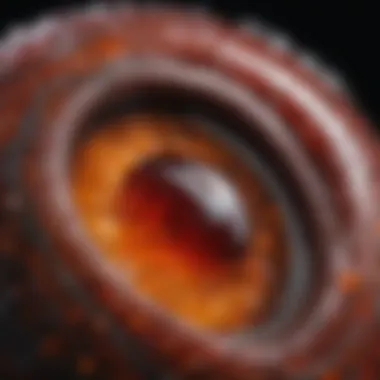Exploring Sard: Geological and Cultural Insights


Intro
Sard, a variety of chalcedony, is a mineral that has captivated human interest for centuries. Its rich color and durability make it a popular choice in jewelry and various art forms. Beyond its aesthetic appeal, sard holds a significant place in geology and cultural history, offering insights into the earth's processes and human creativity.
The mineral exhibits distinct physical and chemical properties. Characterized by its reddish-brown to orange hue, sard is formed through the slow crystallization of silica. Understanding its geological characteristics can provide valuable context for its historical and cultural relevance.
This article aims to provide an in-depth examination of sard, highlighting its key attributes, uses, and significance throughout human history and scientific research.
Key Findings
Sard's features reveal much about its importance. The following points summarize key findings related to this mineral:
- Geological Characteristics: Sard forms primarily in sedimentary rock deposits, often originating from volcanic activity. Its crystalline structure displays unique optical properties, enhancing its appeal in various applications.
- Cultural Significance: Throughout history, sard has been admired for its beauty. Cultures worldwide have used it as a talisman and in decorative arts.
- Scientific Applications: Sard is not just a decorative stone. It serves significant purposes in research, providing insights into earth's formation and conditions.
"The study of sard encompasses not only its physical properties but also its broader implications across science and culture."
Major Results
- Enhanced Understanding of Formation Processes: Recent studies have expanded knowledge on how sard forms within specific geological contexts.
- Cultural Artifacts and Jewelry: Analysis of historical artifacts reveals the widespread use of sard in ancient jewelry, with examples found in archeological digs around the world.
- Modern Scientific Research: Current projects employ sard in geological studies to model ancient environmental conditions.
Discussion of Findings
The interplay between sard's geological formation and its cultural applications presents a rich tapestry for exploration. Its properties can inform how societies have viewed and utilized natural resources. Furthermore, the adaptability of sard in various fields, such as jewelry making and scientific research, underscores its multifaceted role in both artistry and academia.
Methodology
To comprehensively understand sard, a systematic methodology was employed:
Research Design
A combination of historical analysis, geological sampling, and cultural study was utilized to analyze the significance of sard. This approach allows for a holistic understanding of the mineral's impact and applications.
Data Collection Methods
- Literature Review: Extensive examination of academic articles, books, and historical records relevant to sard.
- Field Studies: Geological samples were collected from various sites known for sard deposits.
- Artifact Analysis: Samples of sard used in historical contexts were cataloged and analyzed for composition and craftsmanship.
Prelims to Sard
Understanding sard is crucial for several reasons. First, this mineral provides invaluable insights into geological formations and processes. Sard is not only fascinating from a scientific perspective but also holds significant cultural and historical importance. Its uses span various fields including art, jewelry, and scientific research, providing a multifaceted view of its relevance.
Definition and General Overview
Sard is a type of chalcedony, which is a microcrystalline variety of quartz. It typically presents in a red to brown color, with a translucent appearance. The name "sard" is derived from the ancient city of Sardis, where the stone was historically extracted and traded. This mineral is primarily composed of silicon dioxide, exhibiting a unique combination of hardness and aesthetic appeal, making it an important subject of study in mineralogy.
Sard has been employed in various applications throughout history. Its attractive appearance has made it a favored choice for ornamental items and jewelry. Some individuals also value sard for supposed metaphysical properties, suggesting that it can bring confidence and protection to the wearer. This definition encapsulates not only its physical attributes but also its symbolic meanings across different cultures.
Historical Context and Origins
The history of sard can be traced back to ancient civilizations. It was highly valued by the Greeks and Romans, often used in engraved gems and signet rings. These cultures believed that sard possessed protective qualities, which made it a popular choice for amulets and talismans. Over the centuries, fine examples of sard have been discovered in archaeological sites, emphasizing its long-standing significance.
Sard's origins can be linked to several locations, with deposits primarily found in regions such as India, the Middle East, and parts of Europe. The presence of sard in these areas highlights its accessibility and widespread use in antiquity. In essence, the story of sard is interwoven with human history, representing both natural splendor and cultural heritage. Its legacy continues to evolve as it finds new applications in modern contexts.
Geological Characteristics of Sard


Sard is a fascinating mineral characterized by its unique geological features. Understanding these aspects is crucial as they contribute to sard's value not only as a gemstone but also within its scientific and industrial applications. This section will cover the mineralogical composition, formation processes, and distribution of sard, providing a comprehensive overview of its geological importance.
Mineralogical Composition
Sard primarily consists of silicon dioxide, known as quartz. Its composition can include other elements, which gives sard its unique colors and appearances. Iron oxide, for instance, significantly affects the mineral’s hue, leading to shades ranging from deep red to brownish tones.
The presence of microelements plays a role in defining sard's aesthetic qualities as well. Trace elements such as titanium, manganese, and chromium may also influence the mineral's coloration. Knowing this composition helps in identifying authentic sard when assessing gemstones.
Formation Processes
Sard typically forms in sedimentary environments, and its characteristics evolve over period of time due to environmental conditions. The heat and pressure experienced in metamorphic settings can also lead to the formation of sard.
Two main mechanisms for its creation can be highlighted. First, the crystallization process occurs when silica-rich solutions cool and solidify. Second, sedimentation happens when particles settle over time in a body of water. These processes result in the diverse qualities seen within sard deposits today. The interplay of these factors is significant for geological studies as well as for practical applications in jewelry making.
Distribution and Locations
Sard is typically found in various parts of the world. Notable regions include:
- India: Renowned for high-quality specimens.
- Brazil: Offers a variety of colors and sizes.
- Germany: Home to historical mining sites.
Understanding the distribution of sard is essential for both commercial and academic purposes. Mining locations often correlate with geological compositions, making the study of distribution vital not only for sourcing but also for understanding geological formations globally.
Sard is not only appreciated for its aesthetic qualities but also valued for its geological significance across different continents.
Physical and Chemical Properties
Physical and chemical properties of sard play a crucial role in understanding its significance. These characteristics determine how sard behaves under various conditions, influencing its applications across different fields. Whether in jewelry, industrial uses, or scientific research, recognizing the properties of sard allows for informed decisions about its utilization.
Color and Transparency
Sard typically features a rich reddish-brown hue, which is one of its defining traits. This color results from the presence of iron and other trace elements within its structure. Its transparency may vary from opaque to semi-translucent, depending on the specific sample. The depth of its color can be appealing to artisans, making it a popular choice for jewelry. The interplay of color and transparency contributes to sard's aesthetic value.
Hardness and Durability
Sard is known for its good hardness, scoring around 6.5 to 7 on the Mohs scale. This makes it relatively durable and suitable for various applications. Its resistance to scratching and wear allows it to maintain its appearance over time, which is especially important in jewelry. However, care should still be taken to protect it from harsh chemicals and extreme conditions that could compromise its integrity.
Refractive Index and Luster
The refractive index of sard ranges between 1.54 and 1.55, providing it with a distinctive luster. This property enhances its visual appeal, as light interacts with the surface. Sard often exhibits a vitreous to waxy luster, which adds to its desirability as a gemstone. Understanding the refractive index is significant for gemologists and jewelers, as it assists in identifying and appraising the stone accurately.
Sard's unique properties not only enhance its beauty but also expand its uses in various sectors, showcasing its versatility as a mineral.
Sard in Cultural Context
Sard plays a significant role in understanding various cultural dimensions. Its use across different civilizations showcases not only its aesthetic value but also its deep-seated relevance in symbolism and belief systems. By examining sard's cultural context, one uncovers layers of meaning that reflect historical changes, societal values, and human creativity. This exploration is essential in bridging the gap between the mineral's geological presence and its influence on human activities over centuries.
Role in Antiquity and History
Sard has a storied history that stretches back to ancient civilizations. In antiquity, this mineral was highly valued for its rich colors and durability. It was commonly used in seals and amulets, indicating ownership or status. The Greeks and Romans regarded sard as a gemstone of significance, often associating it with protection and strength. The stone was often believed to ward off negative energy and bring good fortune.
Many artifacts and archaeological findings have confirmed the pivotal role of sard throughout history. For instance, sard's prominence in trade routes illustrates not just its geographical distribution but also its economic importance. Ancient trade exchanges included sard among luxury goods, emphasizing its desirability. The Persian Empire, for example, used sard extensively in jewelry, both as a decorative element and a talisman.
This connection to antiquity reveals a rich tapestry of cultural practices tied to sard, demonstrating how this mineral was intertwined with the craftsmanship of the era.
Sard in Jewelry and Art


In the realm of jewelry and art, sard holds a cherished position. The mineral's warm hues range from reddish-brown to yellowish tones, making it suitable for intricate designs. Artisans throughout history have utilized sard to embellish crowns, brooches, and rings.
In ancient Mesopotamia, sard was often carved with intricate designs depicting mythological scenes or figures. Similarly, the Roman and medieval periods saw the stone gaining popularity in signet rings, where it bore engravings that identified individuals or families. This practice reinforced the mineral’s association with power and identity.
Today, sard continues to be explored by contemporary jewelers, who appreciate its rich heritage alongside its modern applications. Its ability to resonate with themes of tradition and innovation ensures that sard remains relevant in today's artistic circles. Moreover, in galleries and exhibitions, sard's historical pieces are often highlighted, providing an avenue for cultural education and appreciation.
Sard symbolizes a connection between human creativity and the natural world. Its place in both history and artistry offers insights into the values of past civilizations.
Through these lenses, the significance of sard transcends mere mineralogy. Instead, it epitomizes humanity's quest for beauty, power, and identity through time.
Contemporary Applications of Sard
Sard has a versatile role in contemporary industries and research, transcending its aesthetic appeal found in jewelry. Understanding these applications can illuminate the mineral's practical benefits beyond its visual charm.
Industrial Uses
Sard is increasingly recognized in various industrial settings, particularly in the production of abrasives. The hardness of sard makes it suitable for grinding and cutting applications. Industries use sard powder as a finishing material due to its durability and ability to withstand wear.
Moreover, sard finds applications in the creation of composite materials. These materials leverage sard's properties to enhance strength and resistance against environmental factors. For instance, sard-infused composites are valuable in the automotive and aerospace sectors, where lightweight yet strong materials are essential. The growing interest in sustainable materials has also pushed companies to explore alternative natural resources like sard for environmentally friendly production.
- Sard's durability leads to its use in:
- Abrasive powders
- Composite materials for automotive applications
- Sustainable product development
Role in Scientific Research
The scientific community regards sard as significant in several research domains. Its mineralogical properties provide insights into geological processes. Studies focus on the formation and transformation of sard, aiding in understanding how minerals react under different environmental conditions. This can help scientists reconstruct past geological events and predict future mineral behavior.
Additionally, sard is a subject of interest in gemology, as researchers examine its optical properties and formation processes. Analyzing sard under advanced techniques like Raman spectroscopy contributes to the development of new analytical methods in mineralogy. This research can also assist in identifying authentic sard in a market sometimes flooded with imitations.
"Sard serves as a key indicator in geological studies, reflecting the conditions under which it formed. Its properties can serve as benchmarks for research across various scientific fields."
As sard continues to capture the attention of industries and researchers alike, its adaptive uses signify its evolving presence in modern applications. Keeping abreast of these advancements could prove beneficial for educators and professionals engaged in mineralogical studies.
Cultural Significance of Sard
Sard holds a prominent place in various cultures around the world, influencing art, beliefs, and the material culture of several civilizations. Its rich color and durability make it much valued across time periods and geographic boundaries. Understanding the cultural significance of sard provides insights into human interactions with minerals and the symbolic meanings attached to them.
Symbolism and Beliefs
Sard has been associated with various symbolic meanings throughout history. Many cultures attribute a sense of protection and strength to sard. In ancient societies, it was believed to ward off negative energies and ill fate. This mineral was often worn as amulets or in jewelry to safeguard the wearer.
- In biblical texts, sard is mentioned as one of the twelve stones in the breastplate of the High Priest. This connection signifies divine protection and wisdom.
- Different cultures attribute various powers to sard. For instance, in some Eastern traditions, it symbolizes love and passion. It is often used in personal adornments to enhance attraction and strength in relationships.
- The reddish and brownish hues of sard evoke feelings of warmth. Many believe it promotes courage and motivates individuals during harsh times.
Such beliefs have led to sard being incorporated into art and religious artifacts, reinforcing its standing as more than just a mineral; it becomes a carrier of cultural narratives.
Sard in Literature and Folklore
The presence of sard goes beyond mere physical attributes; it finds itself woven into the fabric of folklore and literature. Sard's mentions in ancient texts reflect its esteemed place in storytelling.
- In ancient Greek and Roman literature, sard is often depicted in connection with love and endurance. These narratives emphasize its aesthetic qualities and cultural meanings.
- Folklore in various regions holds that sard brings good luck and prosperity. Many tales recount how heroes wore sard to signify their bravery and integrity.
- Modern literature also references sard to symbolize resilience. Authors and poets evoke sard in their writing when discussing themes of strength and vitality.
"Sard is not merely a stone; it is a storyteller, capturing the essence of our human experience through time."
Environmental Considerations in Sard Mining


The topic of environmental considerations in sard mining is critical in today’s context. As society increasingly prioritizes sustainable practices, the mining industry is under scrutiny. Sard, as a valuable mineral, is often extracted in regions that might be ecologically sensitive. Hence, it is vital to explore the implications of sard mining and how it can be managed responsibly.
Sustainability Concerns
Sustainability is a pressing concern in sard mining. The methods used for extraction can lead to long-term damage to the environment. Many operations utilize techniques that strip natural vegetation and disrupt local wildlife. This can result in habitat loss and biodiversity decline. Additionally, mining activities often generate waste materials, which can contaminate local water sources, affecting both wildlife and human populations.
To mitigate these issues, the implementation of sustainable mining practices is essential. This includes the use of advanced technologies that reduce environmental impact. For example, companies could invest in less invasive extraction methods and practices that rehabilitate land after mining is completed. Moreover, adhering to regulations established by environmental agencies can ensure that operations are less harmful to ecosystems.
Impact on Local Ecosystems
The impact of sard mining on local ecosystems is significant and varies by region. When mining is conducted, the immediate removal of surface layers can lead to soil erosion. This erosion destabilizes the land and can cause sedimentation in nearby waterways. The resultant change in sediment load can alter aquatic habitats, negatively affecting fish populations and other aquatic organisms.
Furthermore, the increased human activity associated with mining can introduce pollutants into the environment. These contaminants have the potential to disrupt food chains. As numerous species are affected, disruption in one area can create a ripple effect throughout the entire ecosystem.
"It's essential to recognize that local ecosystems are deeply interconnected. Mining practices that neglect this interconnectedness can lead to unforeseen consequences."
Thus, it is crucial to conduct comprehensive environmental assessments before mining activities commence. These assessments can identify potential risks and guide the development of mitigation strategies. Additionally, community engagement is key. Local populations should be included in discussions about mining projects, as their insights often provide valuable information about the land and its ecosystems.
In summary, addressing environmental considerations in sard mining is indispensable. Responsible mining practices, alongside rigorous environmental assessments, can mitigate negative effects and help preserve ecological integrity.
Future Research Directions
Understanding sard not only benefits the fields of geology and materials science but also opens avenues for research that can lead to innovative applications. This section presents upcoming strategies in sard research, emphasizing advancements in mineralogy and the potential new applications that emerge from these advancements.
Advancements in Mineralogy
Recent developments in mineralogy focus heavily on how sard can be analyzed and manipulated at an atomic level. Studies have shown that modern techniques like X-ray diffraction and electron microprobe analysis offer detailed insights into sard’s crystalline structure. This knowledge enables scientists to better understand how impurities influence its properties.
Moreover, more sophisticated spectroscopy methods can reveal the subtle electronic properties of sard, shedding light on how these might be employed in electronics or other technology. Such advancements can lead to
- Improved extraction methods, reducing environmental impact.
- Enhanced quality of sard used in various applications.
An essential aspect of ongoing research includes understanding how sard interacts with other minerals. This can help in the development of composite materials that combine the desirable features of multiple minerals. Hence, close collaboration between geologists and material scientists can foster a more profound comprehension of sard’s synergistic properties.
Potential New Applications
The insights gained from mineralogical advancements lead to tangible applications for sard across diverse fields.
In industry, sard's durability and aesthetic qualities make it suitable for use in high-strength abrasives and cutting tools. Also, the vibrant color of sard has the potential for use in a variety of decorative applications, from construction to fashion design. New applications may also emerge in biomedical sciences, where sard’s unique characteristics can be leveraged in the development of diagnostic tools or even in the creation of new biocompatible materials.
Furthermore, there is a promising scope for sard in the world of electronics. Its properties may aid the production of semiconductors or as a component in photonic devices. This research can usher in a new era where sard not only serves as an ornamental stone but also plays a vital role in advanced technological innovations.
"The exploration of sard’s properties could lead to groundbreaking applications, merging ancient materials with cutting-edge technology."
Several relevant studies are being conducted that examine how sard can be adapted for sustainable technologies. The emphasis on minimizing ecological footprints while maximizing efficiency offers a compelling intersection of geology, environmental science, and engineering. The future of sard holds potential not just for those interested in minerals but for a broader audience that includes technologists and environmentalists alike.
End
The examination of sard highlights its multifaceted significance across various domains. Understanding the importance lies not just in the geological or aesthetic aspects, but also in the cultural richness it embodies. Sard’s distinct properties contribute to its wide array of applications, making it pivotal in industrial, artistic, and scientific realms.
Summary of Key Points
- Geological Characteristics: Sard is valued for its mineralogical composition and formation processes that define its unique qualities.
- Cultural Relevance: Throughout history, sard has held symbolic meanings, influencing jewelry-making and artistic endeavors.
- Scientific Applications: As a subject of ongoing research, sard reveals potentials for advancements in mineralogy and diverse applications in modern technology.
- Environmental Considerations: Sustainable mining practices are essential to mitigate the negative impacts on ecosystems, ensuring that future resources are responsibly utilized.
Final Thoughts on Sard
In summary, sard is more than just a mineral; it represents a convergence of natural history, cultural heritage, and scientific inquiry. Its relevance spans past and present, providing insights into human creativity while offering opportunities for future research and applications. Elevating sard's appreciation amongst scholars and enthusiasts alike opens avenues for deeper studies that may yield beneficial advancements and ecological awareness. The enduring legacy of sard continues to inspire, as it intertwines within our cultural narratives and scientific explorations.
"The beauty and significance of sard is found not only in its appearance but in the stories and connections it fosters across time and disciplines."
For those interested in furthering their knowledge on sard and minerals, resources such as Wikipedia and Britannica offer in-depth insights.



